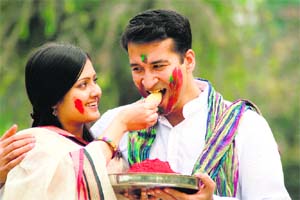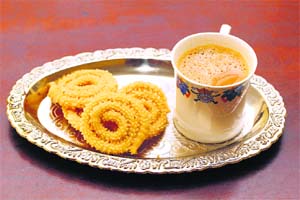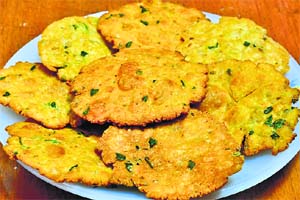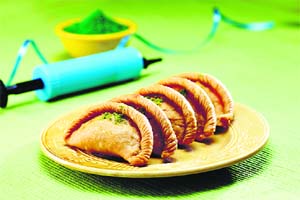|
FESTIVITY
Colour me sweet
Indians love to cook,
celebrate and savour food. Festivals are a good time to indulge in
this favourite pastime
Renu Manish Sinha
 Holi, the festival of
colours, doesn't just last a day. It heralds a season of colours. The
northern parts of India shake loose the shackles of bone-chilling
cold, fog and heavy woollens and eagerly welcome the spring in its
full glory. For the urban winter-weary eyes, jaded with the dreary
landscape of the cold season, colourful flowers are a refreshing
sight, while for the rural brethren their harvest-ready fields are a
sight to behold. Holi, the festival of
colours, doesn't just last a day. It heralds a season of colours. The
northern parts of India shake loose the shackles of bone-chilling
cold, fog and heavy woollens and eagerly welcome the spring in its
full glory. For the urban winter-weary eyes, jaded with the dreary
landscape of the cold season, colourful flowers are a refreshing
sight, while for the rural brethren their harvest-ready fields are a
sight to behold.
In India, food forms the
major part of any festival and Holi is no exception.
However, few dishes like
gujhiya and thandai are equally popular across the
length and breadth of the country albeit with regional twists. This is
especially true of gujhiya, as its fillings vary in different
states.
Despite origins in Uttar
Pradesh, Bihar, Madhya Pradesh and Rajasthan, gujhiya is a
perennial favourite across all places where this festival is
celebrated. Different states have adopted this dumpling with a gusto
and made it their own. In Bihar, gujhiyas are called pedakiya
while the Maharashtrians call it karanji. The Gujaratis know it
as ghughra, while in Tamil Nadu it is called karachika.
In Andhra Pradesh and Karnataka it is called karjikayi. You can
find gujhiyas even in Goa, where Goan Hindus prepare it on
Ganesh chaturthi. These are called nevris.
Vadas
is another dish which pops up across many states with several
different accompaniments. Punjabis savour these as dahi bhallas, often
accomapanied by tamarind chutney. In Rajasthan, kanji vadas are
a Marwari delicacy — moong daal vadas soaked in kanji
(A mixture of black carrots, mustard seeds, black salt and water kept
overnight) are served on Holi. In Maharashtra, these are called bonda
(made of potatoes) and sabudana vadas. The South has its masala
vada, accompaniments and dips can vary from coconut chutney to
curd etc. Bihar offers a non-vegetarian variant in form, mutton vadas
plus the usual dahi vada.
The Hindi belt (Uttar
Pradesh, Madhya Pradesh, Bihar, Rajasthan) has many more Holi special
sweets and savouries, besides the very popular gujhiyas and thandai.
These include gud para, shakkar para, namak para, namak karela
(namak para with a twist, shaped like bitter gourd), methi
mathri, papri, kachaudi, matar kachaudi, puas, pedas, gur ke chawal or
mithe chawal, etc all with their own local twists.
However, most regions
and communities also have indigenous dishes to celebrate Holi and
welcome spring. Maharashtrians make puran poli. In Gujarat, it
is sweet khichidi and basundi, while Madhya Pradesh
likes its kusli, lavang lata and Indori puri palak, among other
delicacies. Bihar likes its puas or malpuas more than the gujhiyas,
as well as sattu ki kachaudi, and bhabhra (a hara
chana pakodi made on Holika dahan). While these and many
other traditional delicacies make the festival even more enjoyable, we
bring you a selection of popular recipes, compiled by well-known chef
Sanjeev Kapoor in a healthier avatar. Happy munching!
 Recipes by Recipes by
Sanjeev Kapoor
THANDAI
Ingredients
Full cream milk
(substitute skimmed milk for healthier version ) 1½ litres (7½ cups)
Saffron a few strands
Sugar substitute 5
tablespoons
 Almonds, blanched &
peeled 25 nos Almonds, blanched &
peeled 25 nos
Cashewnuts, soaked 20
nos
Pistachios, blanched
& peeled 30 nos
Melon seeds (magaz),
soaked 3 tablespoons
Poppy seeds (khuskhus),
soaked 3 tablespoons
Green cardamoms 8-10 nos
Rose petals, dried 20-25
nos
Cinnamon 1-inch stick
Peppercorns 8-10
Method
-
Bring milk to a boil in
a pan. Add saffron and simmer.
-
Grind together almonds,
cashewnuts, pistachios, melon seeds and poppy seeds with a little milk
to a fine paste.
-
Add paste to the milk,
mix well. Simmer for three to four minutes.
-
Grind green cardamoms,
dried rose petals, cinnamon and peppercorns to a fine powder.
-
Add this to the milk
and mix well. Add sugarfree natura Diet Sugar and mix.
-
Chill the milk and
serve.
BHAJANEE CHAKLI
Ingredients
Bhajanee flour 4 cups
rice
 Skinless split black
gram 1 cup Skinless split black
gram 1 cup
Dough
Bhajanee flour 2 cups
Table spreadwith healthy
2 tablespoon
vegetarian omega-3
Salt to taste
Cumin powder 1 teaspoon
Red chilli powder 1
teaspoon
Method
-
Preheat the oven at 180°C.
-
For the bhajanee flour,
dry-roast the rice and black gram separately. Cool completely and
grind separately to a powder and mix.
-
Place two cups of
bhajanee flour in a bowl. Add table spread, salt, cumin powder and
chilli powder, and mix well.
-
Divide the mixture in
half. Take one half and knead into a soft dough with half a cup of
water.
-
When the dough is used
up, make a dough of the remaining flour.
-
Put small portions of
the mixture into a chakli mould and press out several chakli onto a
silicon sheet arranged on a baking tray.
-
Bake in preheated oven
for 15-20 minutes or until golden brown.
-
Allow to cool. Store in
airtight container and serve as required.
-
Chef’s tip: Add 1
teaspoon of sesame seeds to the dough for special occasions.
METHI MATHRI
Ingredients
 Refined flour 2 cups Refined flour 2 cups
Salt to taste
Carom seeds (ajwain) ½
teaspoon
Dried fenugreek leaves 1
tablespoon
Lite table spread 5
tablespoons
Method
-
Preheat the oven at 180°C.
-
Place the flour in a
bowl and add the salt, carom seeds and dried fenugreek leaves and mix
well.
-
Add five tablespoons of
lite table spread and mix well. Add sufficient cold water and
kneadinto hard dough. Cover and rest the dough for fifteen minutes.
-
Divide the dough into
twenty-four equal balls and flatten them slightly. Roll each ball
thinly into small puri and fold in half and then fold again to make a
triangle. Stick a clove at one cornermaking it appear like a paan.
-
Place the mathris on a
baking tray and bake for 20-25 minutes. Serve.
KESARI MALAI PEDA
Ingredients
Milk 4 cups
 Saffron few strands Saffron few strands
Citric acid a pinch
Cornflour (dissolved in
2 tablespoons of milk) 2 teaspoons
Green cardamom powder ¼
teaspoon
Sugar substitute 10
teaspoon
Almonds (chopped) 8
Method
-
Bring milk to a boil in
a deep pan and simmer till it reduces to half its original quantity.
Add saffron and mix well.
-
Mix citric acid in two
teaspoons of water and add to the thickened milk.
-
Add dissolved cornflour
and stir continuously till the mixture thickens.
-
Add green cardamom
powder and mix well.
-
Take pan off the heat
and stir in diet sugar and set aside to cool.
-
Divide the mixture into
eight equal portions and shape them into round pedas.
-
Sprinkle almonds over
the pedas and serve.
GUJHIYA
Ingredients
For the filling
Khoya/mawa 500 gm
 Sugar substitute/Sugarfree
Natura 6 tbsp Sugar substitute/Sugarfree
Natura 6 tbsp
Desiccated coconut 3¼
tsps
Cashewnuts (blanched and
chopped) 15 nos
Almonds (blanched and
chopped) 15 nos
Raisins 20 nos
Green cardamom ½ tsp
or nutmeg powder
For the outer covering
Refined flour (maida) 4
cups
Salt ½ tsp
Ghee 5 tbsps
Gujhiya mould
Method
-
Preheat the oven to 180°C.
-
Mash khoya and roast it
in a deep pan on medium heat till pink. Take off the heat and let it
cool.
-
Add all the other
filling ingredients to the khoya and keep aside.
-
To prepare the
covering, sieve flour and salt and rub in five tablespoons of ghee.
Add enough water and knead into a firm dough. Cover it with a moist
cloth and keep aside for fifteen minutes.
-
Divide the dough into
small balls and roll each ball into a small puri of four inches
diameter.
-
Spread a puri on a
greased gujhiya mould and fill a tablespoon of the filling mixture on
one side.
-
Moisten the edges of
the puri and fold one side of the mould over the other. Press the
edges and remove the excess dough and reuse.
-
Prepare all the
gujhiyas and spread on a damp cloth.
-
Place the gujhiyas on
baking tray and bake for 20-25 minutes. (These can also be
deep-fried).
-
Serve.
|
 Recipes by
Recipes by